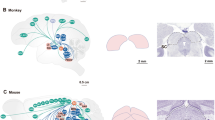Abstract
Cerebellar cortical signals are carried to their principal target, the deep cerebellar nuclear neurons (DCNs), via the inhibitory pathway formed by Purkinje cell (PC) axons. Two different intrinsic properties of DCNs, rebound excitation and automatic firing, have been proposed to support ensuing mechanisms for information transfer via inhibitory synapses. The efficacy of these mechanisms was investigated using whole-cell recordings of spontaneously firing DCNs in cerebellar slices. Results using current injection revealed that both mechanisms are effective in spontaneously firing DCNs but operate at different ranges of membrane potential. Rebound frequency was well correlated to the duration and amplitude of the preceding hyperpolarization. Activation of PC synapses with trains of stimuli few seconds long elicited rebound firing in all tested neurons, demonstrating that inhibition can elicit rebounds in DCNs held at their spontaneous membrane potential. Rebounds could be also elicited by single stimulus in a subset of neurons. The rebound frequency was significantly correlated to the synaptic stimulus strength, supporting the idea that rebound frequency may encode the amplitude of inhibition and thus serve to transfer inhibitory signals in the cerebellar circuit.






Similar content being viewed by others
References
Ito M, Yoshida M, Obata K, Kawai N, Udo M (1970) Inhibitory control of intracerebellar nuclei by the Purkinje cell axons. Exp Brain Res 10:64–80
Jahnsen H (1986) Electrophysiological characteristics of neurones in the guinea-pig deep cerebellar nuclei in vitro. J Physiol 372:129–147
Llinás R, Mühlethaler M (1988) Electrophysiology of guinea-pig cerebellar nuclear cells in the in vitro brain stem–cerebellar preparation. J Physiol 404:241–258
Aizenman CD, Linden DJ (1999) Regulation of the rebound depolarization and spontaneous firing patterns of deep nuclear neurons in slices of rat cerebellum. J Neurophysiol 82(4):1697–1709
Molineux ML, McRory JE, McKay BE, Hamid J, Mehaffey WH, Rehak R et al (2006) Specific T-type calcium channel isoforms are associated with distinct burst phenotypes in deep cerebellar nuclear neurons. Proc Natl Acad Sci U S A 103(14):5555–5560
Aizenman CD, Manis PB, Linden DJ (1998) Polarity of long-term synaptic gain change is related to postsynaptic spike firing at a cerebellar inhibitory synapse. Neuron 21:827–835
Pugh JR, Raman IM (2006) Potentiation of mossy fiber EPSCs in the cerebellar nuclei by NMDA receptor activation followed by postinhibitory rebound current. Neuron 51(1):113–123
Gardette R, Debono M, Dupont J-L, Crépel F (1985) Electrophysiological studies on the postnatal development of intracerebellar nuclei neurons in rat cerebellar slices maintained in vitro. I. Postsynaptic potentials. Dev Brain Res 19:47–55
Thach WT (1968) Discharge of Purkinje and cerebellar nuclear neurons during rapidly alternating arm movements in the monkey. Journal of Neurophysiology 31:785–797
Armstrong DM, Rawson JA (1979) Responses of neurones in nucleus interpositus of the cerebellum to cutaneous nerve volleys in the awake cat. J Physiol 289:403–423
LeDoux MS, Hurst DC, Lorden JF (1998) Single-unit activity of cerebellar nuclear cells in the awake genetically dystonic rat. Neuroscience 86:533–545
Eccles JC (1973) The cerebellum as a computer: patterns in space and time. J Physiol 229(1):1–32
Braitenberg V, Preissl H (1992) Why is the output of the cerebellum inhibitory? Behav Brain Sci 15:715–717
Sausbier M, Hu H, Arntz C, Feil S, Kamm S, Adelsberger H et al (2004) Cerebellar ataxia and Purkinje cell dysfunction caused by Ca2+-activated K+ channel deficiency. Proc Natl Acad Sci U S A 101(25):9474–9478
Uusisaari M, Obata K, Knopfel T (2007) Morphological and Electrophysiological Properties of GABAergic and Non-GABAergic Cells in the Deep Cerebellar Nuclei. Journal of Neurophysiology 97:901–911
Raman IM, Gustafson AE, Padgett D (2000) Ionic currents and spontaneous firing in neurons isolated from the cerebellar nuclei. J Neurosci 20(24):9004–9016
Alvina K, Walter JT, Kohn A, Ellis-Davies G, Khodakhah K (2008) Questioning the role of rebound firing in the cerebellum. Nat Neurosci 11:1256–1258
Perkel DH, Schulman JH, Bullock TH, Moore GP, Segundo JP (1964) Pacemaker Neurons: Effects of Regularly Spaced Synaptic Input. Science 145:61–63
Pedroarena CM, Schwarz C (2003) Efficacy and short-term plasticity at GABAergic synapses between Purkinje and cerebellar nuclei neurons. J Neurophysiol 89(2):704–715
Rowland NC, Jaeger D (2008) Responses to tactile stimulation in deep cerebellar nucleus neurons result from recurrent activation in multiple pathways. J Neurophysiol 99(2):704–717
De Schutter E, Steuber V (2009) Patterns and pauses in Purkinje cell simple spike trains: experiments, modeling and theory. Neuroscience 162:816–826
Muri R, Knöpfel T (1994) Activity induced elevations of intracellular calcium concentration in neurons of the deep cerebellar nuclei. J Neurophysiol 71:420–428
Gauck V, Thomann M, Jaeger D, Borst A (2001) Spatial distribution of low- and high-voltage-activated calcium currents in neurons of the deep cerebellar nuclei. J Neurosci 21(15):RC158
Molineux ML, Mehaffey WH, Tadayonnejad R, Anderson D, Tennent AF, Turner RW (2008) Ionic factors governing rebound burst phenotype in rat deep cerebellar neurons. J Neurophysiol 100(5):2684–2701
Alvina K, Ellis-Davies G, Khodakhah K (2009) T-type calcium channels mediate rebound firing in intact deep cerebellar neurons. Neuroscience 158(2):635–641
Aman TK, Raman IM (2007) Subunit dependence of Na channel slow inactivation and open channel block in cerebellar neurons. Biophys J 92(6):1938–1951
Acknowledgments
This research was supported by the Herrmann and Lilly Schilling Foundation.
Author information
Authors and Affiliations
Corresponding author
Rights and permissions
About this article
Cite this article
Pedroarena, C.M. Mechanisms Supporting Transfer of Inhibitory Signals into the Spike Output of Spontaneously Firing Cerebellar Nuclear Neurons In Vitro. Cerebellum 9, 67–76 (2010). https://doi.org/10.1007/s12311-009-0153-1
Published:
Issue Date:
DOI: https://doi.org/10.1007/s12311-009-0153-1




